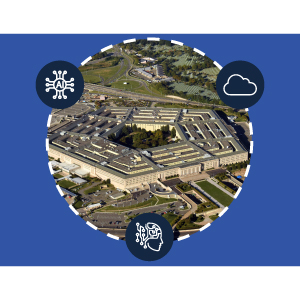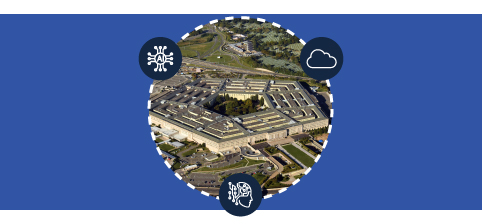This blog series focuses on the Department of Defense (DoD) and Intelligence Community (IC) initiatives for 2023 and beyond. Part one covered future plans regarding IT workforce development and retention, partnerships, interoperability and data management. Part Two continues the discussion of the intertwining initiatives and technologies in AI, ML and cloud computing to provide a more complete picture of the current DoD and IC landscape in connection with their vision for the future.
While data is the lifeblood for the digital transformation, artificial intelligence (AI) and machine learning (ML) are what make digesting the information possible. Cloud allows for this data to be hyperscaled, more agile and more efficient for operations. All of these elements and technologies work together to propel the DoD and IC to the next level and achieve mission goals.
 AI and ML
AI and ML
To properly understand AI and ML’s role in the future of the DoD and IC, some standard definitions must be established. While the private sector mostly utilizes AI for emergency response, healthcare, finance, agriculture and human resources, the military’s most common uses include cyber defense, swarming, vulnerability scanning and data filtration. This creates a stark difference in understanding and terms. For the purposes of this blog, the terms AI and ML will reflect the terms used during the live DoDIIS speeches and discussions.
With AI and ML, one of the biggest hurdles for the IC is explainability. Before new data can be incorporated from other sources, existing data must be processed. CTOs and Directors of the CIA, DIA, National Media Exploitation Center (NMEC) and Virtualitics explained that if current data holdings are not sorted and understood during the data cataloging processes, it will be difficult to utilize AI and understand the results later. Data governance and data strategy are foundational to this effort. All parties involved also need to understand the ethical implications of AI and have a strong grasp of data analysis and machine learning to harness all of these technologies’ true powers. Other safeguards must be put in place to properly introduce the use of AI and ML within their intended contexts. AI testing and evaluation (T&E) is different than for other tech, since AI capabilities should not be set and left without monitoring and a way to update a model in the field. Instead, the models should continue to be supervised over time by system creators and end users across academia, industry and government to preserve accuracy and high precision. The baseline within the hierarchy of needs is ensuring quality data results, which requires clear understanding of the algorithmic approaches being employed for the models. Vendor technology that provides clear AI explainability is particularly sought after in the DoD and IC since it can be used to back tactical life or death decisions. One solution the DoD is pursuing to address this challenge is the machine-as-a-teammate (MaaT) capability which automates data transformation to significantly increase velocity and precision while remaining explainable.
The DoD has begun focusing heavily on ethical AI frameworks including starting toolkits to assess pipeline or model bias and building a Responsible AI (RAI) foundation to ensure responsible, equitable, traceable, reliable and governed use of data. The DoD hopes industry will continue to adopt RAI principles ahead of future requirements and expand on practical ways to attain these best practices. In addition, the DoD established an AI Council to discuss aligning their RAI framework with AI regulations in other European countries as they seek to integrate systems and open the door for efficient data sharing.
Through initializing use of AI and ML, the DoD and IC have already discovered several benefits. AI has offered enhanced workflows and reduced burden on analysts, advanced filtering techniques on large data sets, open-source scanning for improved product reports and optimized data rates for information transfer. DoD ML pilots achieved 100x increase in quality review and 10x increase in pre-decision error/anomaly detection, among other successes. DoD and IC leaders look to AI as gateway to better identify vulnerabilities in military systems, improve the identification of targets or locations and increase accuracy and speed of retrieving battle damage assessments. While the technology exists to perform these tasks, the policies and permissions are not yet complete to fully implement AI and ML.
Handling the massive quantities of data is a huge undertaking; however, processing the information through AI and ML has proven the worth of the endeavor tenfold and delivered clear mission impact. By focusing on the infrastructure first, the DoD and IC can leverage AI and ML for maximum impact to let machines and humans each do what they do best and then team up to solve the problems in between.
While there are some risks to implementing AI completely such as data set accuracy, vulnerabilities to adversarial influence, legal ramifications and expectations of data use tech, DoD and IC officials confidently endorse the transition to incorporating more AI. They recommend several key steps such as creating a common international policy that addresses ethical concerns, technological advancement and dual use; defining AI for policy given the dynamic and changing nature of technology; and identifying definitions and strategies around non-lethal options, hardening systems and mission enhancement. The DIA’s AI strategy aims to achieve AI readiness in the near term, AI competitiveness in the mid-term and AI dominance in the long-term.
The Cloud
According to Dr. Raj G. Iyer, former CIO for Information Technology Reform, Office of the Secretary of the Army, cloud is an absolute necessity to move large amounts of data across the globe. The concept of data-centricity shifting within the Army from theory to doctrine, has precipitated other essential changes including the migration to cloud. Dr. Iyer stated that the new data goals are no longer owned by just “tech folks”, but by every warfighter, which places a new level of priority on technology like cloud. The new Army initiative includes achieving a distributed command and control (C2) structure for the Army to provide more mobility and less centralization both with C2 and the data. This will be attained through the adoption of its Hybrid Cloud of the Future to hide data “in plain sight” and avoid systems that are uniquely military in nature. When the military leverages a commercial platform, it can process data in a way where adversaries cannot differentiate sensitive information from other commercial processes.
Across the rest of the DoD and IC, agencies vary in their level of cloud migration. For the NGA, business applications and analytics are already in the cloud, the next step is to move to a hybrid multicloud with resources that need to be on hardware available at Joint Regional Edge Nodes. The NSA hopes to avoid a lift-and-shift approach, and instead be precise with their cloud investments through initiatives such as Hybrid Cloud Compute, Eagle Crossing, and a Human Capital Management System. DISA has brought cloud programs together for the DoD under their Host and Compute Center (HACC) through the Joint Warfighting Cloud Capability (JWCC) contract.
For agencies which have not migrated, the DoD and IC recommend preparing for cloud deployment and utilizing this time before switching to cloud to eliminate bad practices that exist on-prem and focus on relevance, resourcing and complete system readiness. As other technologies and strategies take effect, DoD and IC officials reminded of the importance of prioritizing cloud first, cloud native and Zero Trust baked in throughout every aspect regardless of cloud migration stage.
Some challenges DoD and IC officials presented to industry were how to maintain service if an outage occurs in regional data centers from a classified perspective and how to maintain and optimize the network from a unified comm perspective considering its sensitivity to latency. Overall, leaders inquired how to preserve reliability and redundancy to overcome potential distrust of the cloud. As the DoD and IC collaborate with industry to innovate and resolve these issues, it continues to unlock new doors of potential. Dr. Iyer stated that the network is no longer an enabling function, and these digital technologies are now changing how the DoD and IC fundamentally view warfighting.
As the DoD and IC seek to accomplish these IT goals and prepare the way for future modernization, industry, academia and other government agencies must come together to solve current challenges, innovate new solutions and support mission initiatives. Government leaders noted the importance of these modernization efforts and that the technologies and strategies developed in the next 5-10 years will be the foundation of operations for the next generation.
Check out our Fast Facts and Future Initiatives of the DoD and IC Resource for more information and key insights for the IT industry.
*The information contained in this blog has been written based off the thought-leadership discussions presented by speakers at DoDIIS 2022.*








